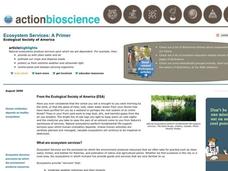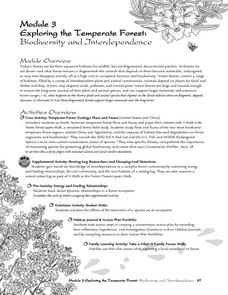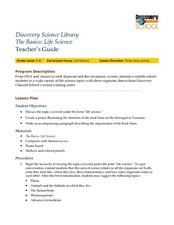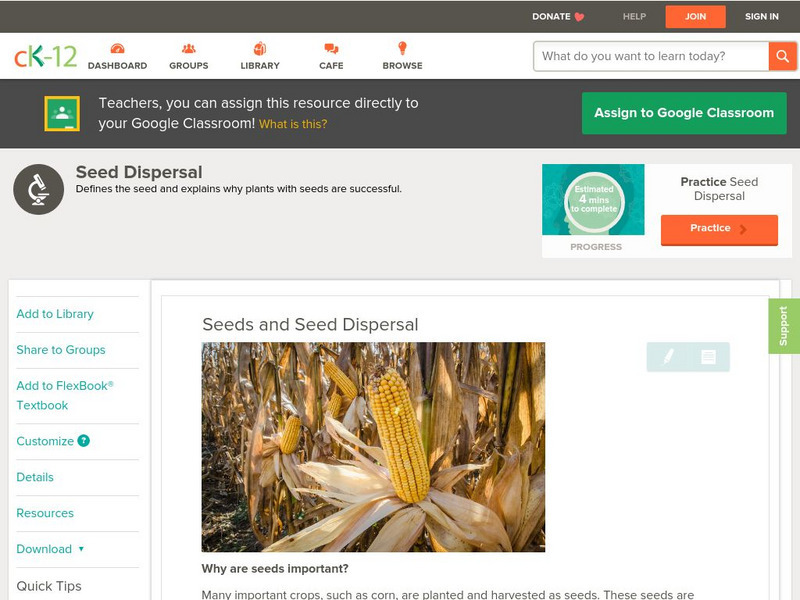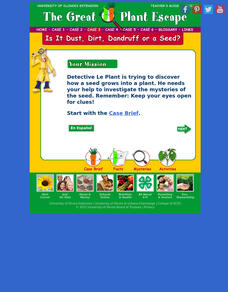Curated OER
Food Chain: what's for dinner?
Fourth graders identify where foods came from and sequence a food chain. In this food chain lesson, 4th graders define vocabulary related to food chains and order a food chain. Students follow the energy of a food chain. Students...
Curated OER
Coevolution: A Simulation
Young scholars participate in a demonstration in which they must attempt to suck liquid from varying containers with straws of varying sizes. They discuss the concept of coevolution and see why this activity illustrate the coevolution...
Curated OER
How Much Is an Ecosystem Worth?
Students examine the value of ecosystems. They read and analyze an article, evaluate ecosystem services, research the benefits of biomonitors, and design a public service announcement.
Curated OER
Web of Life - Role-Playing
Students role-play how organisms adapt to their environment. They play 20 questions with plant and animal habitats. They create a web of life to demonstrate how each plant and animal relies on the other for survival.
Curated OER
Exploring the Temperate Forest: Biodiversity and Interdependence
Students examine the consequences of cutting down large amounts of forests throughout the world. In groups, they use the internet to complete a module taking them on a tour through different temperate forests. To end the lesson, they...
Curated OER
The Basics:Life Science
Students explore concepts in life science using segments drawn from Discovery Channel. In this life science lesson, students participate in discussions about the food chain. Students create a poster to illustrate a predator and prey...
Curated OER
Forest Food Web
Students explore the elements of a forest ecosystem. They examine the elements needed to form a forest food web. Students construct and describe food webs that include nonliving elements of the ecosystem.
Curated OER
Rain Forest Animals
Students create a book about animal species found only in the Amazon rain forest. They find one species to represent each letter of the alphabet, and write each name on a different piece of paper. They illustrate each page with an...
Curated OER
Bat Facts
Student's demonstrate an understanding of basic facts about bats by creating a picture representation of bats in their habitat describing information they learned. The lesson plan is especially favorable for visual learners.
Curated OER
Exploring Bats
Third graders create a graphic organizer about bats in cooperative groups. The graphic organizer is used to illustrate the information that has been researched. The specific graphic organizer is the KWL.
Missouri Botanical Garden
Missouri Botanical Garden: Biology of Plants: Seed Dispersal
Learn about methods of seed dispersal. Includes videos, photos, and lesson plans.
Utah Education Network
Uen: Sock Walk (Seed Dispersal)
Activity helps with the understanding of seed dispersal.
CK-12 Foundation
Ck 12: Life Science: Seeds and Seed Dispersal
[Free Registration/Login may be required to access all resource tools.] Plants seem to grow wherever they can. How? Plants can't move on their own. So how does a plant start growing in a new area? Learn more about seeds and seed...
Other
Science and Kids Activities: Pollination and Seed Dispersal
Second graders learn how plants depend on animals to disperse their seeds. Students will learn about ways that animals can disperse seeds. They will design their own model and compare it to the real action of plants and animals. In the...
PBS
Pbs Kids: Plum Landing: Seed Racer
This PBS Kids activity is an extension of a Plum Landing episode featuring seed dispersal. Students will play a game in which they collect seeds. Students will collect different types of seeds, and then students will learn facts...
E-learning for Kids
E Learning for Kids: Science: California: What Is Seed Dispersal?
Nikki is learning about plant seed dispersal methods. Join in and learn how this is important to plant reproduction.
CK-12 Foundation
Ck 12: Life Science: 7.9 Seed Dispersal
Learn how plants disperse their seeds for successful reproduction.
University of Illinois
University of Illinois Extension: The Great Plant Escape Parts of a Seed
Help Detective Le Plant discover how a seed grows into a plant. Students will learn to describe a seed's structure and what's needed for seed growth.
Science Buddies
Science Buddies: Gone With the Wind: An Experiment on Seed and Fruit Dispersal
If you have ever made a wish and blown the fluff of a dandelion, you have witnessed how some plants are adapted to spreading their seeds using the wind. The tiny, furry parachute allows the seeds to be picked up by the wind and to be...
Science Buddies
Science Buddies: How Many Seeds Do Different Types of Fruit Produce?
Do you like your strawberry jelly with or without the seeds? Are you glad to have a seed-free watermelon, or do you enjoy spitting the seeds into the garden? You might not like to find seeds in your fruit, but fruit is nature's way of...
PBS
Pbs Teachers:a Model of Seed Dispersal
Investigate propagation systems in plants, and explain the ways some animals disperse seeds through their digestive processes. Role-play and map the daily travels of one seed-bearing animal to explore the migration of seeds.
Science & Plants for Schools
Science & Plants for Schools: Pollination, Fertilization, Fruits [Pdf]
Great PDF to teach students about plant reproduction and life cycle. There are many teacher printables.
DOGO Media
Dogo News: The Ingenious Stork's Bill Seed Plants Itself!
Learn about the Erodium cicutarium, a plant also known as the stork's bill, that has a unique way of dispersing its own seeds. Includes video.
CK-12 Foundation
Ck 12: Third Grade Science: Life Science: Plant Reproduction and Life Cycles
[Free Registration/Login may be required to access all resource tools.] Read about the processes of sexual reproduction in flowering plants, including pollination, fertilization (seed production), seed dispersal, and germination.




